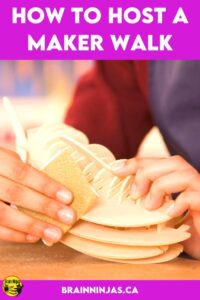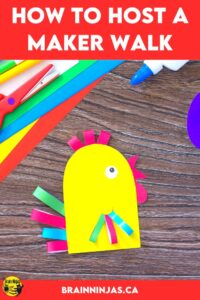
Are your students using your makerspace and now you want to show off their hard work? Host a Maker Walk. Picture a science fair, but so much cooler because it’s filled with the creations your students made in your makerspace!
This can be done with the school’s makerspace or you can just use the creations your students have created from your classroom’s makerspace (like us),
First of all, if you don’t have a makerspace and you’re looking for reasons why you should, you need to read our post: Why Makerspaces? It will give you some information about the skills students can develop by using the makerspace and being creative.
If you are wanting to start a makerspace but you aren’t sure how to get it going, you can check out two of our more popular posts: How to Create an Inviting Makerspace and What to Put in a Makerspace?
What is a Maker Walk?

If you’ve ever run a science fair, you know the basics of organizing the event. The difference between a science fair and a maker walk is very small. During a science fair, entries are judged and there are winners and prizes, but the object of a Maker Walk is to let the makers talk to each other, share their creations and inspire each other. Instead of judging, look to let the makers give each other feedback so they can improve as makers going forward.
What is the Maker Movement?
The idea of making something has meant different things to different generations. While home economics once taught girls to sew and cook, these types of courses are not usually offered anymore in exchange for options like robotics and film studies.
There is nothing wrong with that, but our students have the desire to make stuff. Just watch what happens when you let a group of ten years loose with the craft supplies. They’ll put googly eyes and glitter on everything!
This love of making doesn’t go away as we get older, but we do allow our inhibitions to get in the way. If it’s not practical or beautiful, we tend to believe we aren’t good enough at making and then we give up. Our busy lifestyles make it difficult to get good at cooking and who sews anymore?
Allowing students to explore these once-common skills is a great way to let them be creative and you don’t need to know how to do anything to let them learn something. This is a generation of students who know how to find things on YouTube and will learn things from there.
Ninja Note: We had a student learn to weave baskets after watching a tutorial on basket weaving from YouTube. Students can learn anything! One of the ninjas also learned how to fix a dryer using YouTube-don’t under estimate it!
If you’re looking for some posters for your makerspace, we have a set of colourful posters that you can find for free in our Resource Library. We can send you a set when you sign up for our email list. The set includes an ink-saving version if you don’t have a colour printer.
How Do You Set Up a Maker Walk?

Choose a place
It needs to be flexible enough to allow a variety of creations in the space along with enough room for people to walk around and explore the different entries. Popular or spectacular entries might need a little extra space to demonstrate how their creation works so be sure to leave lots of room between entries. Have lots of electrical outlets available as some of your participants will need them. You may also want tables and chairs for participants to use.
Choose a time
The time needs to be when members of your community can view the creations. Also for a period of time when makers can talk to each other and talk about their projects. Makers love to talk and learn from other makers. It’s part of the maker culture, so it’s important to foster this learning.
Invite visitors
Encourage others to come to see the creations. Invite classmates, teachers and local community members. The first event will always be a little smaller. As it catches on, the word will spread and you’ll have more makers than you can handle.
The event can be mandatory (like for a class project). We’ve typically had better results and better projects just asking for participants to volunteer to join. These makers WANT to be there and they are excited to share what they’ve made.

Use categories
If you have a large number of entries, you might want to sort them into categories. Some of the categories we’ve used in the past are: foods, fabric/thread arts (this included knitting, crocheting, weaving and sewing), electronics/coding/technology, inventions, tools, and arts (music, painting, crafting). There could be so many more!
We don’t usually have prizes, but our makers love to talk about what they’ve created and share it with others.
Plan it
We created an organizational product to help you plan out all the details. It includes examples of some of our events, pictures, possible themes and materials to get you inspired. Find the Host a Maker Walk planning guide in our TpT Store ($USD) or BN Shop ($CAN).
The Downside-Yes, there is one.
We had one major downside the first time we tried this-don’t make the same mistake.
Parents!
There are no winners…or losers!
We had parents who created the whole project because they wanted the project to “win.” To counter this, we tried a few different things.
- We explained the purpose of the Maker Walk. And that there wouldn’t be prizes, but just the chance to interact with other makers.
- We offered students the chance to work on their projects at school before and after and since it was our classroom, parents were encouraged to drop their children off and then mosey on down the hall. When the projects went home they came back “tweaked” in ways typical nine year olds didn’t usually do.
- We set out guidelines about what would need to be explained or demonstrated. We didn’t need a project to be finished to show it off, so it took the pressure off students to get things done (and therefore didn’t ask their parents for as much help).
Is someone being too…helpful?

And parents aren’t the only ones who over-help (we’re not sure that’s a real word, but you know what it means). Teachers are guilty of it too. Turn off every possible instinct to help your students too much with their creations. Demonstrate without touching their projects, guide them to resources, and ask them questions, but do not do anything. Let them be creative.
If you’re an overly helpful teacher you might benefit from our post How to Work Through the Design Process or Are You Accidentally Teaching Helplessness? They both have ideas on how to get students willing to take learning risks.
When you do things or redo things that students are working on, it sends the message that their work isn’t good enough. This will be enough to make many students not bother. They know you’ll just come along and fix it.
We want your students to want to fix it all on their own, so let them.
The Best Part of a Maker Walk
Our students had so much fun getting the chance to learn new things and share their passions for different inventions and creations. The enthusiasm was so contagious.
We hope your students enjoy the Maker Walk as much as ours have. Having a Maker Walk gives students the chance to be creative with an end goal in mind. And you can never have just one. We do three per year (one for each term) and we still have students who bring in projects all year round.
Be sure to check out maker events in your community. You might be surprised to know there are Maker Faire events and Make Something gatherings right in your very own town or city. They are usually grassroots efforts so search them out on social media.
Be sure to tag us in any photos as our students would love to see the creations around the world!







